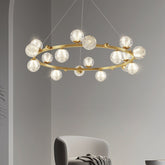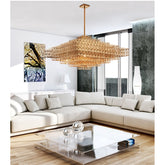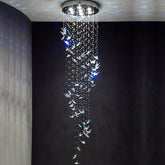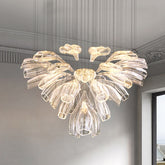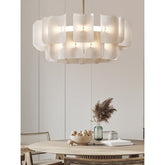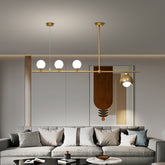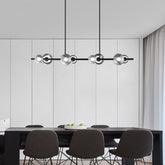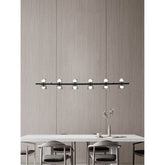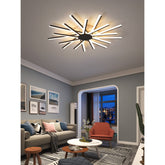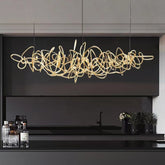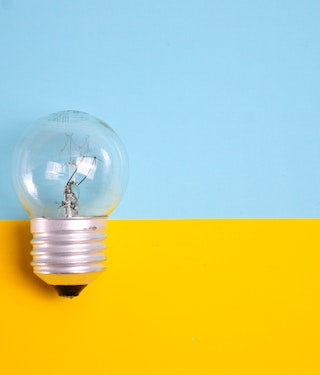The Positive Influence of a Well-Designed Light for People
Lighting is a crucial aspect of our daily lives, whether we primary realize it or not. From the moment we wake up to the time we go to bed, light surrounds us, impacting our mood, productivity, and overall well-being. The right light can help us feel energized and motivated, while poor lighting can leave us feeling lethargic and unmotivated. But have you ever stopped to think about the design of the light in your room and how it affects you?
This article aims to delve deeper into the influence of a well-designed light in the room on people. We will explore how the right light can positively impact our mood, increase our productivity, and help us relax and unwind. We will also examine the connection between light and sleep quality and offer tips on selecting the right light source to create a well-lit space.
So, whether you're looking to boost your mood, increase your productivity, or simply create a calming environment, read on to discover the positive influence a well-designed light can have on your life.
The impact of lighting on mood
Light has a profound impact on our mood and emotions, thanks to its psychological effects on the human brain. When we experience different levels and colors of light, it triggers the release of hormones and neurotransmitters that can affect our mood and overall spirit.
For instance, bright and cool lights like daylight can stimulate the production of serotonin, a hormone that helps regulate mood, appetite, and sleep. On the other hand, dimmer and warmer lights can induce the release of melatonin, a hormone that promotes relaxation and sleep.
But it's not just the type of light that matters, but also the design of the light itself. A well-designed light can help improve mood by providing the right balance of brightness and color temperature to suit your specific actions and requirements. For example, a bright and cool light can be ideal for a workspace, while a dim and warm light can create a cozy atmosphere in a living room.
Moreover, a well-designed light can also mimic natural light, which has been shown to have a positive effect on mood and mental health. Natural light can help regulate circadian rhythms and improve alertness and mood, while also reducing stress and anxiety. By incorporating natural light into a well-designed light in the room, we can create a space that promotes overall calm vibes and positivity.
Safety and security
Well-designed lighting can positively influence the safety and security of people in both indoor and outdoor environments too. Adequate lighting can help to prevent accidents by providing sufficient illumination for individuals to see potential hazards and obstacles. It can also deter criminal activity by making it easier for individuals to see potential threats and intruders. Outdoor lighting can be particularly effective in improving safety and security by illuminating pathways, parking lots, and building exteriors. In indoor environments, proper lighting can help individuals navigate and move around the space safely, reducing the risk of falls and other accidents. Additionally, emergency lighting systems can be implemented to ensure that occupants are able to safely evacuate a building in the event of a power outage or emergency situation. By prioritizing safety and security through well-designed lighting, individuals and organizations can create a more secure and comfortable environment for people.
Lighting and productivity
Lighting can have a significant impact on our work efficiency and productivity, with studies showing that poor lighting can lead to eye strain, headaches, and even fatigue. On the other hand, a good light can help increase productivity by improving focus and reducing eye strain, allowing us to work for longer periods without feeling tired or overwhelmed.
The link between lighting and work efficiency lies in the type of light used and the design of the light. A well-designed light can provide the right amount of brightness and color temperature to suit our work needs, while also reducing glare and shadows that can cause eye strain.
For instance, a bright and cool light can be ideal for tasks that require concentration and attention to detail, such as reading, writing, or working on a computer. It can help increase alertness and focus, making it easier to stay on task and complete work efficiently.
In contrast, a dim and warm light can be more suitable for tasks that require relaxation and creativity, such as brainstorming or idea generation. It can create a cozy and calming atmosphere, allowing the mind to wander and come up with new ideas without feeling overwhelmed or stressed.
By incorporating a good light into the workspace, we can create an environment that promotes productivity and efficiency, allowing us to work more effectively and achieve our goals with ease.
Accessibility
Lighting design can have a significant impact on the accessibility of spaces for people with disabilities. Adequate lighting levels can help people with visual impairments to navigate spaces more easily, while contrast lighting can help to improve depth perception and reduce the risk of falls. Additionally, lighting can be used to highlight important features, such as doorways, staircases, and emergency exits, making it easier for individuals with mobility impairments to move around safely. By considering the accessibility impact of lighting design, individuals and organizations can create spaces that are more inclusive and welcoming for people with disabilities.
Energy efficiency
Energy efficiency is a crucial aspect of well-designed lighting systems that positively influences people. Lighting systems that are energy-efficient use less energy to produce the same amount of light as traditional systems. This results in lower energy costs and reduces greenhouse gas emissions, helping to combat climate change. Furthermore, energy-efficient lighting systems have a longer lifespan, which means they require less maintenance and replacement, resulting in further cost savings over time. By implementing energy-efficient lighting systems, individuals and organizations can reduce their carbon footprint and contribute to a more sustainable future. In addition to the environmental benefits, energy-efficient lighting systems can also enhance the comfort and well-being of occupants, creating a more pleasant and inviting space.
Lighting and relaxation
In today's fast-paced world, relaxation is more important than ever. With so many demands on our time and attention, finding ways to unwind and de-stress can be a challenge. However, one simple way to promote relaxation is by incorporating a well-designed light into your living space.
A good light can create a calming and comfortable atmosphere, helping to reduce stress and anxiety. By using dim and warm lights, we can create a cozy environment that promotes relaxation and encourages us to unwind after a long day. Additionally, a well-designed light can also reduce eye strain and headaches, which can contribute to feelings of stress and discomfort.
Moreover, a good light can also help regulate our sleep-wake cycle, promoting restful sleep and overall well-being. By using natural light or a light that mimics natural light, we can help regulate our circadian rhythms, which can improve our sleep quality and help us feel more rested and refreshed.
Incorporating a well-designed light into your living space can be an easy, simple yet very effective way to promote relaxation and well-being too. By creating a calming and comfortable atmosphere, you can reduce stress and anxiety, improve sleep quality, and promote overall health and happiness in the long run.
Aesthetic appeal
Aesthetic appeal is an important aspect of well-designed lighting systems that can positively influence people. Good lighting design can enhance the visual appeal of a space, highlight architectural features, and create a more inviting and comfortable environment. For example, a well-lit room with the appropriate color temperature and intensity can enhance the colors and textures of surfaces, artwork, and furniture. Furthermore, lighting can be used creatively to add drama and interest to a space, such as using accent lighting to highlight artwork or feature walls. Outdoor lighting can also be used to create a welcoming ambiance, highlighting architectural features and landscaping elements. By considering the aesthetic impact of lighting design, individuals and organizations can create spaces that are visually appealing and enjoyable for people to occupy.
The influence of light on sleep
Light plays a crucial role in regulating our sleep-wake cycle, as it affects the production of hormones that control our internal clock. Exposure to bright and cool light during the day can help keep us alert and awake, while exposure to dim and warm light in the evening can help promote relaxation and prepare our bodies for sleep.
However, in today's world, we are often exposed to artificial light sources that can disrupt our natural sleep patterns. This is because artificial light, especially from electronic devices, emits blue light that can suppress the production of melatonin, the hormone that promotes sleep.
To combat this, a well-designed light that emits dim and warm light in the evening can be helpful in promoting sleep quality. By using a light with a low color temperature, we can reduce exposure to blue light and promote the production of melatonin, which can help us fall asleep faster and sleep more deeply.
Moreover, using a light with a timer or dimmer switch can also help regulate our sleep-wake cycle, allowing us to gradually wind down and prepare for sleep. This can be especially helpful for those who have trouble falling asleep or staying asleep, as it can promote a more restful and rejuvenating night's rest.
References
- Heschong Mahone Group. (2003). Windows and offices: A study of office worker performance and the indoor environment. https://h-m-g.com/projects/daylighting/studies/windows-and-offices/
- International Association of Lighting Designers. (2018). The value of good lighting design. https://www.iald.org/About/Lighting-Design/Value-of-Good-Lighting-Design
- S. Department of Energy. (2021). Energy-efficient lighting. https://www.energy.gov/energysaver/save-electricity-and-fuel/lighting-energy-efficient-homes/energy-efficient-lighting












































































































